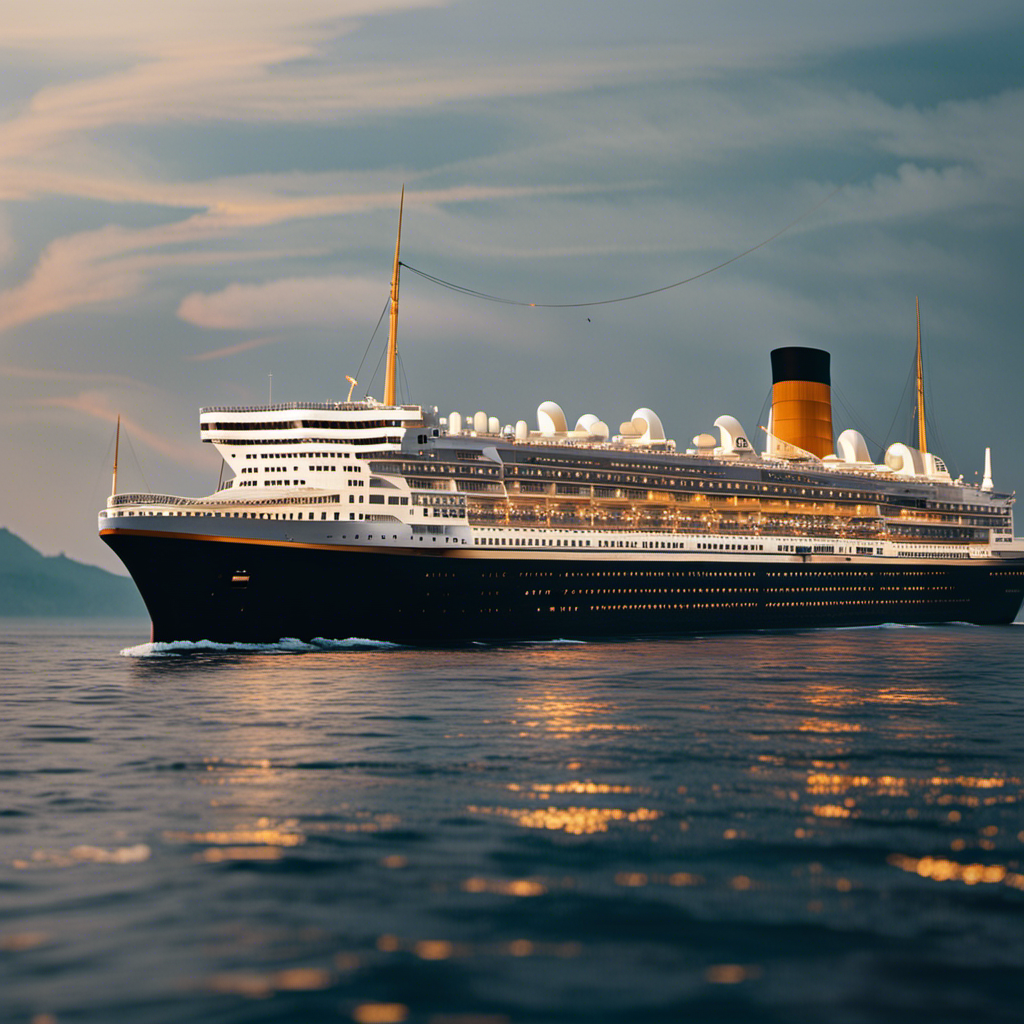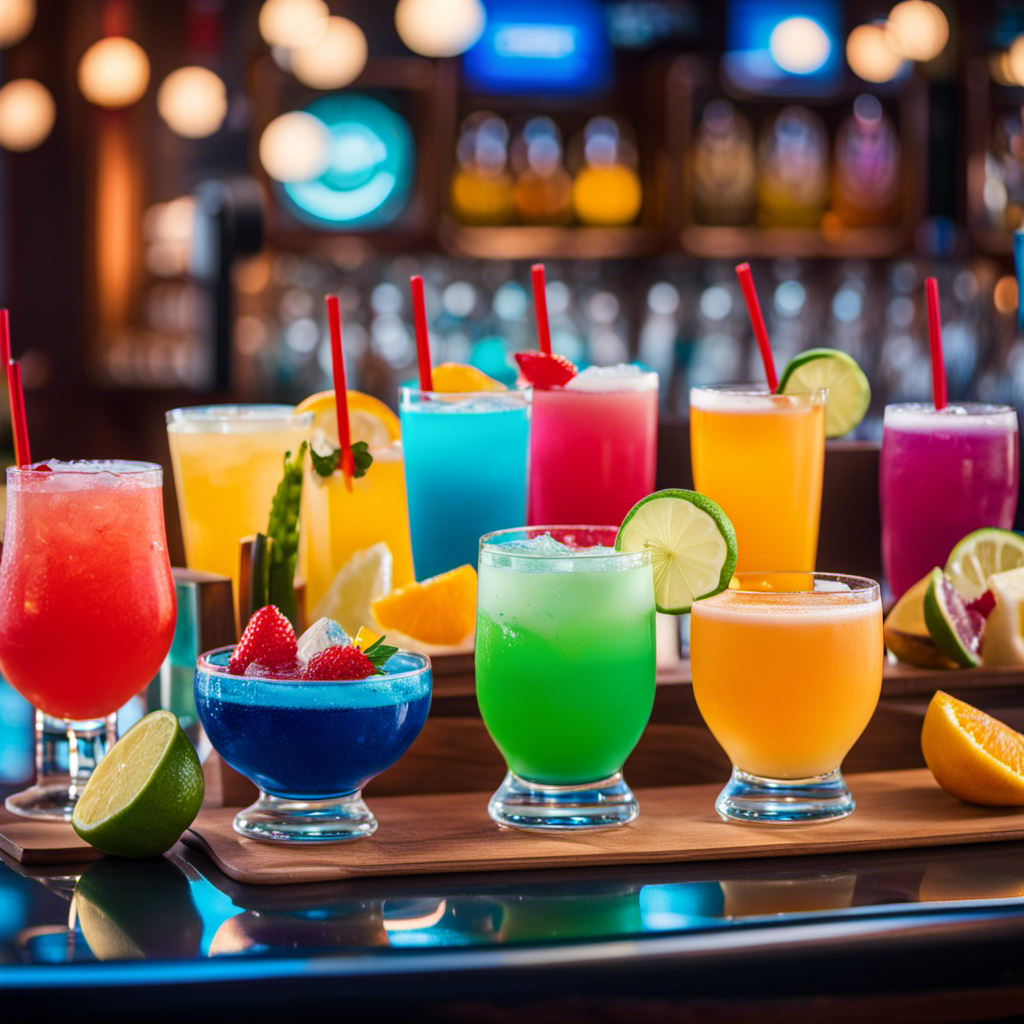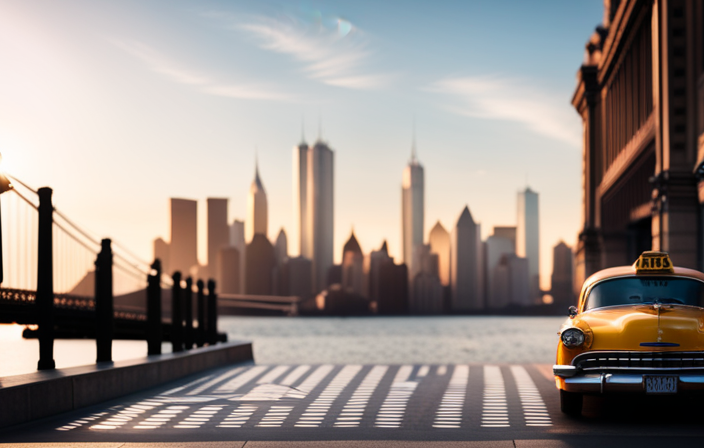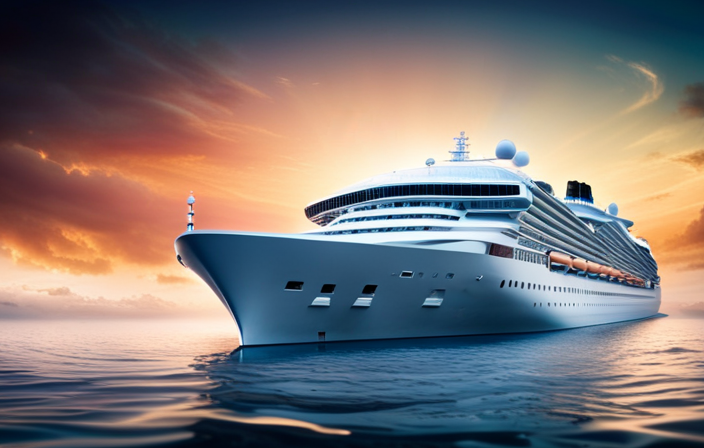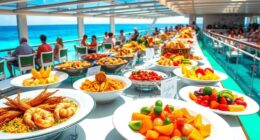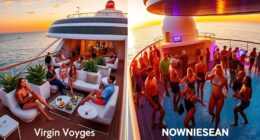As an enthusiast of sea adventures, the grandeur of the Titanic has often captivated my imagination.
Did you know that the Titanic, with its length of 882 feet, was nearly three times smaller than modern cruise ships?
In this article, we’ll delve into the historical significance of the Titanic’s size, comparing its dimensions, passenger capacity, amenities, and engineering feats to those of today’s cruise ships.
We’ll also explore the evolution of safety measures and the lasting impact of the Titanic’s sinking on maritime regulations.
Join me on this fascinating journey through the Titanic’s enduring legacy.
Key Takeaways
- The Titanic’s size was groundbreaking for its time, but modern cruise ships have surpassed its dimensions, stretching over 1,000 feet in length.
- Modern cruise ships are equipped with state-of-the-art amenities and offer a wide range of entertainment options for thousands of passengers and crew members.
- Technological advancements in shipbuilding have revolutionized safety measures and navigation systems in the maritime industry, leading to enhanced fuel efficiency, maneuverability, and accuracy.
- The sinking of the Titanic prompted the establishment of international safety regulations, such as SOLAS, and has shaped cruise ship construction and safety regulations, including improved communication systems, lifeboat capacity, and emergency response plans.
Historical Significance of the Titanic’s Size
The Titanic’s size was groundbreaking for its time and continues to be a point of historical significance. Constructed in the early 20th century, the ship was a marvel of engineering and design. Its massive dimensions were a testament to the ambition and innovation of the era.
The construction techniques employed in building the Titanic were state-of-the-art for the time, with a focus on strength and stability. The ship featured a double-bottomed hull and sixteen watertight compartments, which were intended to prevent flooding in case of an accident. These construction techniques were considered advanced and contributed to the Titanic’s reputation as unsinkable.
Understanding the historical significance of the ship’s size and construction techniques sets the stage for exploring its dimensions: length, width, and height.
Dimensions of the Titanic: Length, Width, and Height
When discussing the dimensions of the Titanic, it is impossible not to be impressed by its sheer size. At the time of its construction, the Titanic was the largest ship in the world, measuring approximately 882 feet in length, 92 feet in width, and 175 feet in height.
However, modern cruise ships have far surpassed the Titanic’s dimensions, thanks to advancements in technology.
Titanic’s Impressive Size
Comparing the Titanic to modern cruise ships, you won’t believe how impressive its size was. The historical significance of the Titanic cannot be overstated. It was one of the largest and most luxurious ships of its time, and its size alone was a testament to the engineering marvels of the early 20th century.
Here are some mind-blowing facts about the Titanic’s size:
- The Titanic was over 882 feet long, which is equivalent to about four football fields.
- It had a width of 92 feet, providing ample space for numerous luxurious amenities.
- The ship stood at a height of 175 feet, towering over the surrounding ocean.
The sheer scale of the Titanic was breathtaking, and it set a new standard for the size and grandeur of ocean liners.
Now, let’s explore the dimensions of modern cruise ships and see how they compare to the legendary Titanic.
Modern Cruise Ship Dimensions
You won’t believe how massive and luxurious modern cruise ships are. With advancements in shipbuilding technology, these floating cities have become architectural marvels.
The dimensions of modern cruise ships are truly mind-boggling. They can stretch over 1,000 feet in length and rise several stories high, accommodating thousands of passengers and crew members.
These ships are equipped with state-of-the-art amenities, offering passengers a wide range of entertainment options, luxurious accommodations, and gourmet dining experiences. From expansive swimming pools and water parks to theaters, casinos, and spas, there is something for everyone on board.
The advancements in shipbuilding technology have allowed for the construction of these colossal vessels, providing stability, safety, and comfort for passengers.
However, the impact of technology on cruise ships goes beyond their size and amenities. Transitioning into the subsequent section, technology has also revolutionized the way these ships operate and navigate the seas.
Impact of Technology
With technology constantly advancing, it’s incredible how much the cruise industry has evolved in terms of safety measures and navigation systems. The evolution of ship propulsion has played a significant role in this transformation. Here are three key advancements that have revolutionized the industry:
-
Transition to diesel-electric propulsion: This shift from traditional steam engines to diesel-electric systems has enhanced fuel efficiency and reduced environmental impact.
-
Introduction of pod propulsion: These innovative propulsion systems, with their 360-degree rotating propellers, provide better maneuverability and increased stability, making for a smoother sailing experience.
-
Utilization of advanced navigation technology: Digital navigation systems, such as GPS and radar, have greatly improved the accuracy and reliability of ship navigation, ensuring safer journeys for passengers.
These advancements, driven by the impact of digital technology, have revolutionized the cruise industry and set the stage for further innovations.
As we delve into the comparison of passenger capacity between the Titanic and modern cruise ships, it becomes evident how these technological advancements have influenced the design and capabilities of these floating marvels.
Comparing Passenger Capacity: Titanic Vs. Modern Cruise Ships
To really understand the difference in passenger capacity between the Titanic and modern cruise ships, imagine yourself stepping on board one of those massive vessels today. The sheer size and scale of these modern ships is truly astonishing. Thanks to technological advancements, these ships can accommodate thousands of passengers at once, far surpassing the capacity of the Titanic.
Not only do modern cruise ships have larger dimensions, but they also have innovative designs that maximize space and efficiency. These ships are equipped with state-of-the-art amenities, such as luxurious cabins, multiple dining options, entertainment venues, and recreational facilities. The passenger experience on modern cruise ships is truly unparalleled, offering a wide range of activities and entertainment options for everyone.
Now, let’s delve into exploring the Titanic’s luxurious amenities without taking a step back in time.
Exploring the Titanic’s Luxurious Amenities
After exploring the passenger capacity of the Titanic compared to modern cruise ships, let’s now dive into the luxurious amenities that made the Titanic an enduring legacy in the history of ocean liners.
The Titanic boasted an array of opulent features, including:
- Grand Staircase: A majestic staircase made of oak and wrought iron, adorned with intricate carvings and a glass dome.
- Turkish Baths: Lavish bathhouses with marble interiors, offering hot and cold treatments.
- First-Class Dining Saloon: A lavish room with ornate wood paneling and chandeliers, where passengers indulged in exquisite meals.
These luxurious amenities were a testament to the Titanic’s commitment to providing an unparalleled experience for its passengers.
With its luxurious features, the Titanic set a new standard for ocean travel. But how did its engineering feats compare to other ships of its time?
Titanic’s Engineering Feats: How Did It Compare?
The engineering feats of the Titanic were revolutionary for their time. This magnificent ship was a true marvel of its era, boasting several innovative features that set it apart from other vessels.
One of the most notable aspects of its construction was the use of advanced materials. The Titanic was built using a combination of steel and iron, which provided unprecedented strength and durability. This allowed the ship to withstand the immense pressure of the ocean depths. In comparison, modern cruise ships primarily use steel in their construction, benefiting from advancements in material science.
The use of different construction materials highlights the progress made in shipbuilding technology over the years. As we delve deeper into the influence of the Titanic on shipbuilding technology, we can see how its engineering feats paved the way for future advancements in the industry.
Titanic’s Influence on Shipbuilding Technology
In terms of maritime technology, the Titanic had a significant influence on shipbuilding. Its construction and subsequent sinking had a profound impact on the industry, leading to important advancements in ship design and safety measures. Here are some key ways in which the Titanic influenced shipbuilding technology:
-
Double hull construction: The Titanic’s double hull design, which featured an outer and inner hull, became a standard in shipbuilding to enhance structural integrity and minimize damage in case of accidents.
-
Watertight compartments: The ship was divided into multiple watertight compartments, which helped to contain flooding and prevent the rapid sinking of the vessel.
-
Improved communication systems: The Titanic’s tragic fate highlighted the need for better communication at sea, leading to the development of advanced radio systems on ships.
-
Enhanced lifeboat capacity: The disaster exposed the inadequacy of lifeboats on board, prompting regulations to increase the number of lifeboats and improve their capacity.
-
Safety regulations: The sinking of the Titanic led to the establishment of international safety regulations, ensuring that ships are equipped with adequate safety measures.
These innovations and regulations have shaped the shipbuilding industry and continue to influence the design and construction of modern cruise ships.
Transition: Now that we have explored the influence of the Titanic on shipbuilding technology, let’s delve into the evolution of safety measures, comparing the Titanic to today’s cruise ships.
The Evolution of Safety Measures: Titanic Vs. Today’s Cruise Ships
Let’s take a look at how safety measures have evolved from the time of the Titanic to now.
The evolution of safety protocols and advancements in cruise ship technology have significantly improved the safety standards on board modern cruise ships.
In the early 20th century, the Titanic was considered unsinkable, but its tragic sinking highlighted the need for better safety measures.
Today, cruise ships are equipped with advanced navigation systems, state-of-the-art life-saving equipment, and comprehensive emergency response plans.
Fire detection and suppression systems, advanced lifeboats, and improved communication systems have also been developed to enhance passenger safety.
These advancements in safety technology have made cruising one of the safest forms of travel.
However, the impact of the Titanic’s sinking on maritime regulations cannot be overlooked.
Impact of the Titanic’s Sinking on Maritime Regulations
Take a moment to consider how the sinking of the Titanic influenced the development of maritime regulations.
The tragic event of the Titanic’s sinking in 1912 led to a significant evolution of maritime regulations and safety measures. Prior to the disaster, there was a lack of comprehensive regulations governing ship construction and safety protocols.
However, the sinking of the Titanic highlighted the urgent need for improved safety standards and practices in the maritime industry. As a result, numerous regulations were implemented, such as the International Convention for the Safety of Life at Sea (SOLAS), which established requirements for ship construction, emergency procedures, and lifesaving equipment.
These regulations continue to evolve, with ongoing efforts to enhance safety measures and ensure the well-being of passengers and crew. This focus on safety has had a profound impact on the cruise industry, which we will explore further in the next section.
Titanic’s Impact on the Cruise Industry
When it comes to the impact of the Titanic on the cruise industry, two key points to consider are the changing safety regulations and the influence on ship design.
The sinking of the Titanic led to a significant overhaul of safety regulations in the maritime industry, with the establishment of organizations such as the International Convention for the Safety of Life at Sea (SOLAS). These regulations have greatly improved the safety standards and practices on cruise ships.
In terms of ship design, the Titanic disaster highlighted the need for better compartmentalization and the inclusion of more lifeboats, leading to the development of safer and more advanced ship designs in the cruise industry.
Changing Safety Regulations
You might be surprised to learn that safety regulations for cruise ships have significantly changed since the time of the Titanic. Over the years, the cruise industry has made tremendous advancements in emergency response and implemented changing safety protocols to ensure the well-being of passengers and crew members. These changes have been crucial in preventing accidents and improving the overall safety of cruise ships.
One of the key areas where safety regulations have evolved is in emergency response systems. Modern cruise ships are equipped with state-of-the-art technology, including advanced fire detection and suppression systems, as well as sophisticated communication systems that allow for quick and efficient response in case of emergencies. Additionally, cruise ships now conduct regular drills and training sessions to prepare the crew for various emergency scenarios.
To highlight the changing safety regulations, let’s take a look at a comparison between safety measures on the Titanic and modern cruise ships:
| Titanic | Modern Cruise Ships |
|---|---|
| Limited lifeboats | Abundant lifeboats and life rafts |
| Inadequate communication systems | Advanced communication systems |
| Lack of safety drills | Regular drills and training sessions |
| Insufficient fire safety measures | Advanced fire detection and suppression systems |
These advancements in emergency response have had a significant influence on ship design, as cruise ships are now built with safety as a top priority. From the inclusion of multiple evacuation points to the installation of advanced safety systems, every aspect of ship design is now carefully considered to mitigate risks and ensure the safety of passengers and crew members.
Influence on Ship Design
The advancements in emergency response have greatly influenced the design of modern cruise ships. The influence on shipbuilding techniques and the impact on maritime history cannot be understated. Here are three ways in which emergency response advancements have shaped the design of modern cruise ships:
-
Enhanced safety measures: The lessons learned from the Titanic disaster have led to the implementation of stricter safety regulations. Modern cruise ships are equipped with state-of-the-art technology, including advanced fire suppression systems, improved lifeboat designs, and comprehensive emergency response plans.
-
Evacuation procedures: The Titanic’s tragic sinking highlighted the need for efficient and orderly evacuation procedures. Today, cruise ships have designated muster stations, lifeboat drills, and trained crew members to ensure a speedy and organized evacuation in the event of an emergency.
-
Communication systems: The development of advanced communication systems has revolutionized emergency response on cruise ships. Modern vessels are equipped with satellite communication systems, allowing for real-time communication with onshore authorities and enabling swift coordination of rescue efforts.
These advancements in emergency response have not only improved the safety of cruise ship passengers but have also had a significant impact on maritime history. From the tragedy of the Titanic to the subsequent improvements in ship design, emergency response has shaped the way we build and operate cruise ships today.
The enduring legacy of the Titanic in popular culture is a testament to its impact on the collective imagination.
The Titanic’s Enduring Legacy in Popular Culture
One of the reasons the Titanic continues to capture the imagination of people around the world is its enduring legacy in popular culture.
Despite the tragic events surrounding its maiden voyage, the Titanic’s popularity has only grown over the years.
From books to movies, songs to documentaries, the story of the Titanic has been retold countless times, cementing its place in our collective consciousness.
Its cultural impact cannot be overstated.
The Titanic has become a symbol of human hubris, a cautionary tale of the consequences of overconfidence.
It has also become a symbol of the enduring spirit of resilience and hope.
The Titanic’s legacy in popular culture serves as a reminder of the power of storytelling and the enduring fascination we have with historical events.
Frequently Asked Questions
What Was the Cost of Building the Titanic?
The cost of constructing the Titanic was around $7.5 million, which is equivalent to about $190 million today. This included the use of high-quality construction materials, such as steel, rivets, and wood.
Did the Titanic Have Any Sister Ships?
Yes, the Titanic did have sister ships, the RMS Olympic and HMHS Britannic. Comparing their sizes, it is clear that the Titanic was a massive feat of engineering and its tragic sinking had a profound impact on shipbuilding.
How Long Did It Take to Build the Titanic?
It took around 26 months to build the Titanic. The construction process was a monumental undertaking, given the scale and complexity of the project. The cost of construction was estimated to be around $7.5 million.
Were There Any Famous Passengers on the Titanic?
There were several notable individuals on board the Titanic, including John Jacob Astor IV, Benjamin Guggenheim, and Isidor Straus. These famous passengers added to the allure and tragedy of the ship’s ill-fated maiden voyage.
How Many Lifeboats Did the Titanic Have?
The Titanic had a lifeboat capacity of 1,178 people, but only 20 lifeboats were onboard. This design flaw proved catastrophic, as there were not enough lifeboats to save everyone on board.
Conclusion
In conclusion, the Titanic’s size was truly remarkable for its time, but it pales in comparison to the massive cruise ships we see today.
However, its legacy lives on through its historical significance and the lessons learned from its tragic sinking.
As the adage goes, ‘history repeats itself,’ and it is important for the cruise industry to constantly evolve and prioritize safety measures to prevent future disasters.
The Titanic’s impact on maritime regulations and the cruise industry cannot be understated, reminding us of the importance of constant improvement and vigilance in the quest for safer and more enjoyable travel experiences.

